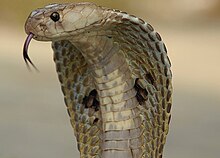NAJA
|
Naja Temporal range: Miocene-Holocene |
|
|---|---|
 |
|
| Naja naja, Indian cobra | |
| Scientific classification | |
| Kingdom: | Animalia |
| Phylum: | Chordata |
| Class: | Reptilia |
| Order: | Squamata |
| Suborder: | Serpentes |
| Family: | Elapidae |
| Genus: |
Naja Laurenti, 1768 |
Naja is a genus of venomous elapid snakes known as cobras. Several other genera include species commonly called cobras (for example the ring-necked spitting cobra and the king cobra), but members of the genus Naja are the most widespread and the most widely recognized as "true" cobras. Various species occur in regions throughout Africa, Southwest Asia, South Asia, and Southeast Asia.
Until recently, the genus Naja had 20 to 22 species, but it has undergone several taxonomic revisions in recent years, so sources vary greatly. Wide support exists, though, for a 2009 revision that synonymised the genera Boulengerina and Paranaja with Naja. According to that revision, the genus Naja now includes 28 species.
The origin of this genus name is from the Sanskrit nāga (with a hard "g") meaning "snake". Some hold that the Sanskrit word is cognate with English "snake", Germanic: *snēk-a-, Proto-IE: *(s)nēg-o-, but this is unlikely. Mayrhofer calls this etymology "unglaubhaft ", "not credible", and suggests a more plausible etymology connecting it with Sanskrit nagna, "hairless, naked".
Naja species vary in length and most are relatively slender-bodied snakes. Most species are capable of attaining lengths of 1.84 m (6.0 ft). Maximum lengths for some of the larger species of cobras are around 3.1 m (10 ft), with the forest cobra arguably being the longest species. All have a characteristic ability to raise the front quarters of their bodies off the ground and flatten their necks to appear larger to a potential predator.
...
Wikipedia
